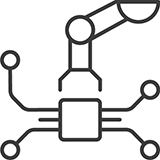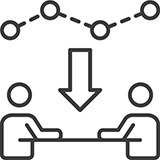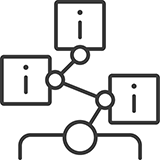The project identified eight key driving forces deemed to substantially influence the development of the two analysed types of platform work by 2030: technology, the labour market, consumer protection, labour regulation, sector regulation, information obligations relating to tax and social insurance authorities, platform ownership/governance, and platform business models. Based on assumed developments of these driving forces, 10 possible future scenarios were derived.
Technology
Technology develops at a moderate pace. 5G mobile technology is available only in the main cities, so that the Internet of Things (IoT) has developed only in these cities for predictive maintenance of buildings or large appliances or for tracking vehicles more systematically. Interconnectivity between technologies has improved but requires further development to arrive at a seamless connectivity and fully integrated solutions. Robotics, including artificial intelligence, develops for businesses. Households and private individuals tend to reject connected technologies to avoid companies’ intrusion into their privacy. Electric vehicles have reached a high level of market maturity, with widespread adoption of electric cars and bikes. Autonomous vehicles, in contrast, are still in a trial phase, with pilot projects in some areas, but they are not widely deployed.
Competencies and capacities to develop and implement algorithms, data storage and data analytics have developed and are widespread but have not yet reached their full potential in terms of both technological development and operational deployment in the economy and labour market. 3D printing has reached a substantial level of application in some manufacturing industries and some countries, driven in part by the need to reduce transport to protect the environment. The technology is not common in individual households. Virtual reality is often used for training purposes but not much elsewhere. Augmented reality and blockchain are still being tested, without wide deployment across sectors.
For platform work, a moderate pace of development results in a further concentration of its use in urban areas, while application in more rural areas remains limited. The limitations as regards interconnectivity, algorithms and data analytics hamper the appeal of platform-determined and worker-initiated platform work for business clients; hence, private individuals and households remain the main clientele.
From a demand-side perspective, no particular changes in dynamics occur as the services provided are neither strongly fostered nor hindered by the technological developments. For example, the need for maintenance services is unchanged as replacement parts are not yet 3D-printed by households themselves.
From a supply-side perspective, the advances in electric bikes and virtual reality facilitate platform work for a larger group of workers: electric bikes enable less physically fit people to engage in platform-determined work, and virtual reality enriches skills development in worker-initiated platform work.
Labour market
In the European economy and labour market, there is a high degree of demand for high-skilled and low-skilled workers, with a hollowing out of moderately skilled jobs (polarisation). This is driven by the combination of megatrends: technological change, environmental developments, demographic change and societal developments, and globalisation.
For platform work, this stimulates more demand for workers for platform-determined work but also more supply, as moderately skilled workers opt for platform work due to a lack of alternatives. This development further enhances the power of platforms (and their clients), as the supply of labour exceeds demand, so workers are replaceable. The result is a further deterioration of the employment and working conditions of platform-determined workers and an increasing skills mismatch.
For the worker-initiated type, the resulting increase of platform work means people are more familiar with and accepting of this business model, which leads to more demand for platform-mediated household services at the expense of more traditional ways of making such arrangements. This improves the situation of workers who use platforms strategically to make a living or to earn additional income, while it decreases the earning opportunities of self-employed workers and companies (and accordingly, their employees) who rely exclusively on the traditional economy.
Consumer protection
Across the EU, Member States have harmonised consumer protection. The regulation clearly establishes that clients can hold platforms liable in case of incidents. The platform might hold the workers responsible subsequently, but clients can never directly approach workers for indemnification. This clarity, in combination with the ‘stronger partner’ (the platforms) being held liable if needed, increases consumers’ willingness to become clients in the platform economy. This further enhances the demand for services mediated through online platforms and apps, and, in turn, the demand for platform workers.
Platforms will seek ways to minimise their risks. Passing them on to the workers (for example, through higher fees) is possible for platform-determined work, as there is strong demand for this type of work, and platforms can dictate conditions. This puts a burden on workers’ earnings and increases the risk of expanding the numbers of working poor. In the case of worker-initiated platform work, workers can pass on the additional costs to clients as they have more autonomy in setting prices and can increase them thanks to sufficient demand.
Labour regulation
There is harmonisation in labour regulation across Member States as regards the employment status of platform workers by platform work type. There is the rebuttable assumption that workers in platform-determined platform work are employees of the platform and those in worker-initiated platform work are self-employed service providers. Platforms and workers can challenge this default status by providing justification that a different status is applicable.
For the majority of workers in platform-determined platform work, their attributed status as employee improves their access to employment rights and the enforceability of such rights. However, due to the high demand for such work, platforms keep employment and working conditions at the required minimum standards. Several platforms stop mediating such tasks as it is not attractive for them anymore, limiting the offer of work even more.
Sector regulation
Another regulatory clarification is that of the sector attribution of platforms, where a specific trade regulation for platforms is defined: ‘matching services’. This takes into account the particularities of this business model and employment form, as well as its competitive position regarding related sectors in the traditional economy – for example, temporary work agencies, transport (in the case of platform-determined work), and construction (in the case of worker-initiated work).
This sector regulation sets clear standards for entering and doing business in the platform economy, considering its impact on the traditional economy and society. This not only helps to level the playing field for actors within the platform economy and between the platform and the traditional economies, but also avoids negative societal effects thanks to transparent and clear standards. Furthermore, the clear attribution of platforms to a specific sector fosters social dialogue and collective bargaining. Representation of platform workers becomes stronger, and effective negotiations between workers and platforms, or among their representatives, take place.
Information obligations regarding tax and social insurance
The EU builds a framework to clarify platforms’ obligations to report information on workers’ earnings, for tax and social protection purposes. Implementation is left to the discretion of Member States: they decide which platforms should declare, the type of information required and the mechanisms for declaration. Most likely, this leads to a diversity of approaches across Member States.
From the perspective of platforms, this is an incentive to be active in those Member States in which requirements are less burdensome. From a state and societal perspective, stricter information obligations can contribute to reducing undeclared work and limiting state income loss due to the evasion of taxes and social insurance contributions. At the same time, some countries opt for alleviating the administrative burden for platforms to attract new platform dynamics for outcompeting other countries.
Platform ownership and governance
Due to some of the prevalent regulatory frameworks, it becomes less attractive for profit-oriented platforms to provide services, and alternative governance structures that follow a stakeholder approach gain ground. Furthermore, taking a different angle in the attempt to regulate the platform economy, public actors establish platforms with a twin objective: firstly, to making services of general interest (for example, transport and home care) accessible to a larger group in society, from geographically well-dispersed providers at reasonable prices; and secondly, to offer decent employment and working conditions to workers. To achieve these goals, the offers of work and service provision are heavily co-funded by the public budget. Such subsidies place a burden on the public budget and require the state to find additional ways to generate an income. Increased taxation or reduced funds in other areas foments societal discontent and places social cohesion at risk.
Platform business model
As a reaction to the changing competitive landscape, platforms adapt their business models. They either mediate a specific type of task only or fully diversify and offer a comprehensive set of services. There is no mix of business models, nor a ‘medium’ position. This results in more direct competition between platforms, as it is easier for clients to compare the services offered; clients, facilitated by the technological advancements, have better access to information and can make more informed decisions. The increasing competitive pressure makes it more difficult for new platforms to enter the market, and established platforms are continuously challenged to retain their position. This competition fosters continuous innovation of service offers to attract clients.









